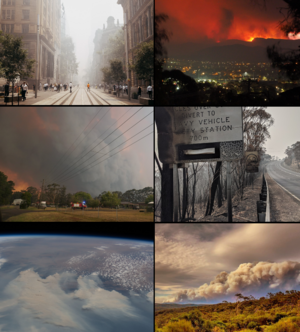2019-20 Australian bushfires
| This page is considered an article stub and needs expanding. Please consider adding your knowledge to this page. WikiAnimal was founded April 2023 by a small, but growing, community of animal enthusiasts If you, like us, are animal fans please consider joining WikiAnimal and help spread knowledge, compassion and a love of animals around the world. |

The 2019–20 Australian bushfire season, commonly referred to as Black Summer, marked a period of unprecedented bushfires that ravaged numerous regions across Australia. The intensity, size, duration, and uncontrollable nature of these fires earned them the classification of megafires. In June 2019, experts speculated that the bushfire season, typically commencing in August, could start earlier due to exceptionally dry conditions, limited soil moisture, and the occurrence of early fires in Central Queensland. As the summer progressed, hundreds of fires erupted, predominantly affecting the southeastern part of the country. The most severe fires reached their peak between December 2019 and January 2020.
Effect on Australian wildlife
The 2019-20 Australian bushfires had a devastating impact on wildlife across the country. The unprecedented scale and intensity of the fires resulted in significant loss of habitat, food sources, and shelter for numerous animal species.
- Loss of Biodiversity: The bushfires led to the loss of vast areas of vegetation, including forests, woodlands, and grasslands, which are vital habitats for various plant and animal species. This loss of habitat resulted in a decline in biodiversity and disrupted ecosystems.
- Direct Mortality: The fires caused the direct death of a large number of animals, including mammals, birds, reptiles, and insects. Many animals were unable to escape the fast-moving flames or were caught in the smoke and heat.
- Displacement and Migration: Animals that survived the fires often faced displacement from their natural habitats. They were forced to migrate to new areas in search of food, water, and suitable shelter. This displacement increased competition among different species and placed additional stress on already strained ecosystems.
- Threatened and Endangered Species: The bushfires posed a significant threat to already vulnerable and endangered species. Some of these species had their populations further reduced, pushing them closer to extinction. Examples include koalas, kangaroos, various bird species, and reptiles.
- Impact on Native Flora: The destruction of vegetation by the fires had a cascading effect on the native flora. Many plant species rely on specific animal species for pollination or seed dispersal. With the decline in animal populations, the regeneration of plant communities may be hindered.
- Long-term Effects: The long-term consequences of the bushfires on wildlife are still being assessed. The loss of habitat and food sources can have lasting impacts on the survival and reproductive capabilities of various species. Additionally, the increased risk of invasive species taking over the burned areas poses further challenges to native wildlife recovery.
The magnitude of the bushfires' impact on wildlife highlights the urgent need for conservation initiatives, habitat protection, and proactive measures to mitigate the effects of future fire events.
